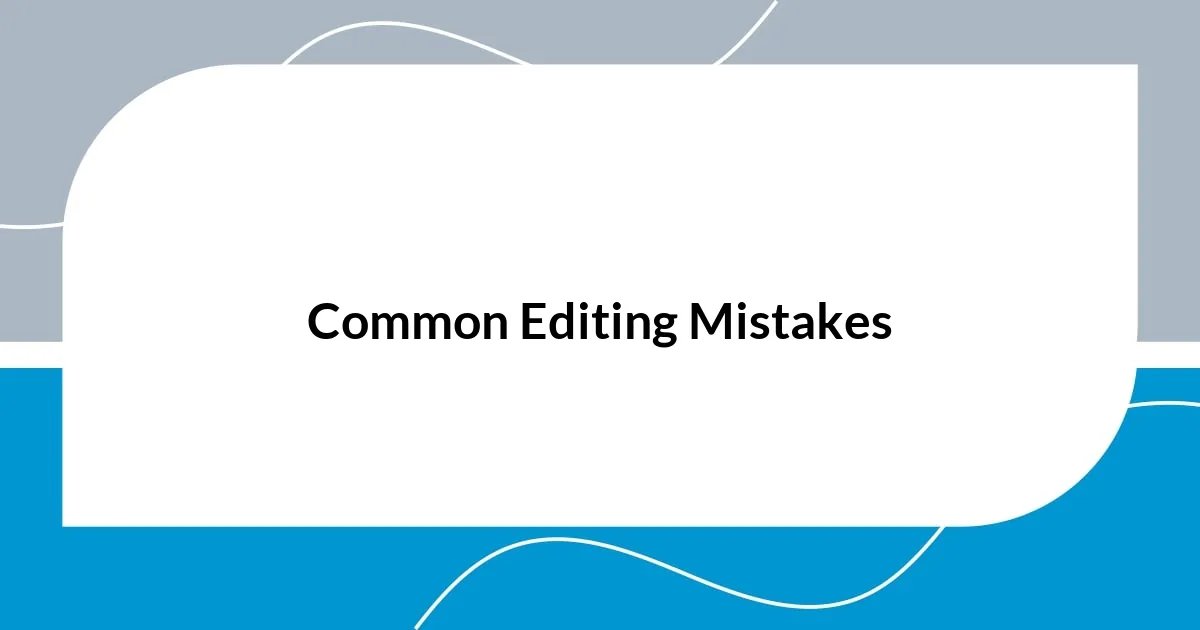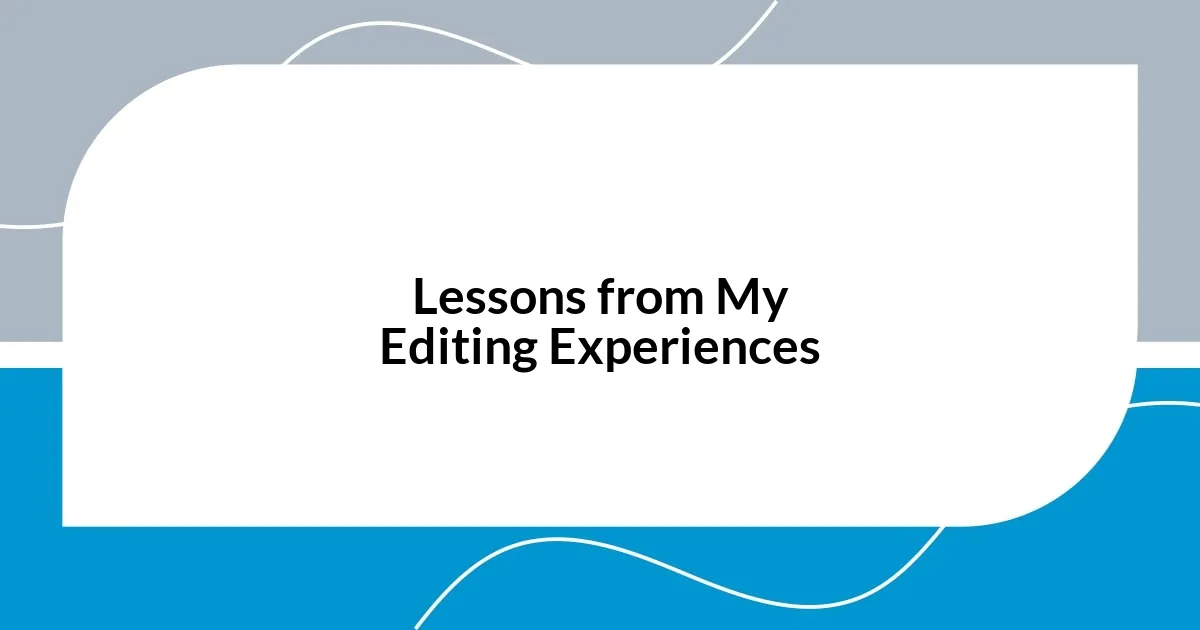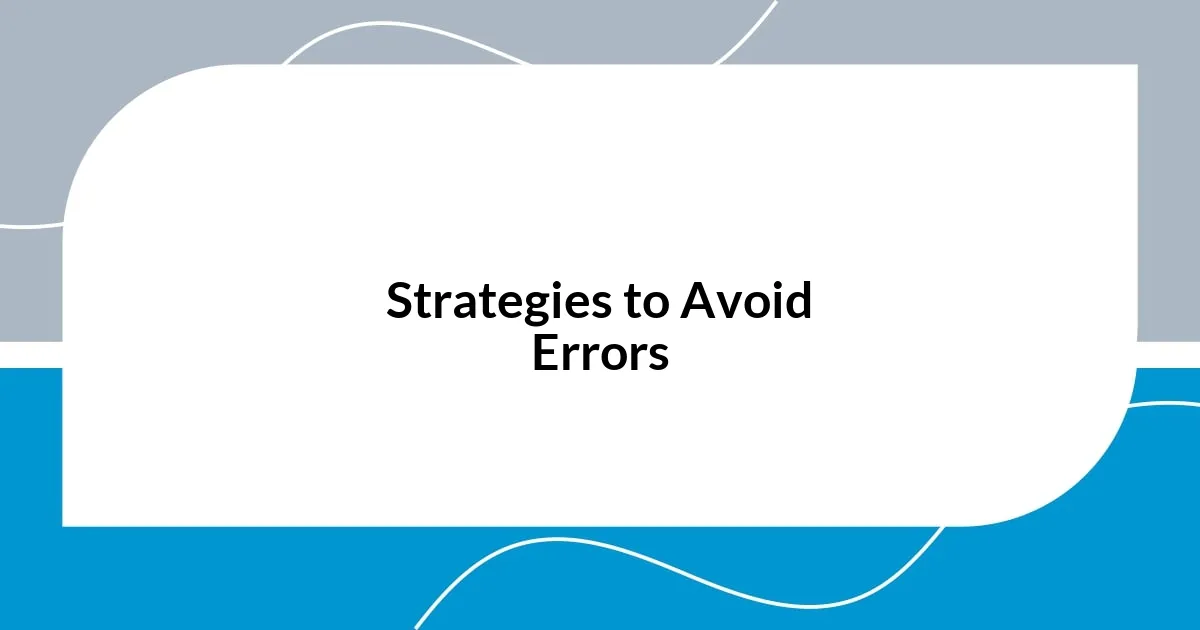Key takeaways:
- Editing disasters often stem from rushed processes, highlighting the need for patience and reflection to improve writing quality.
- Common mistakes include inconsistent tone, neglecting proofreading, and over-editing, which can compromise the voice and clarity of a piece.
- Effective strategies involve breaking the editing process into stages, reading aloud for rhythm, and seeking peer feedback to uncover blind spots.
- Using checklists and prioritizing structural edits can provide clarity and help maintain focus throughout the editing journey.

Understanding Editing Disasters
Editing disasters can range from minor typos to major structural flaws, and understanding their root causes is essential for growth. I remember the first time I inadvertently altered a character’s backstory—it completely changed the narrative arc and left readers confused. Have you ever made a mistake that was so glaring you wondered how you missed it?
Often, the pressure to meet deadlines can cloud our judgment. In my earlier projects, I learned that rushing through the editing process doesn’t just harm the piece—it drains the joy from the creative experience. There’s something about stepping back and giving yourself that critical time to breathe that can save you from a potential disaster.
I’ve come to appreciate how editing disasters often reveal our blind spots. Reflecting on my own work, I realized that I tended to overlook repetitive phrases. Why do we sometimes cling to our words like they’re precious gems? Breaking free from that attachment allows us to elevate our writing, ultimately transforming potential disasters into opportunities for clarity and improvement.

Common Editing Mistakes
Editing is quite the journey, and along the way, I’ve stumbled upon a number of common mistakes that can really trip us up. One thing I often did was focus too much on the big picture, neglecting to fine-tune the smaller details. That led to some awkward phrasing and syntax errors that, looking back, should have been easy to catch. It’s disheartening to realize how such oversights can undermine even the best ideas.
Here are a few editing mistakes that I commonly face:
-
Inconsistent Tone: Switching between formal and informal language can confuse readers and dilute your message.
-
Neglecting Proofreading: Skipping that final read-through means missing typos, misplaced punctuation, or even whole words.
-
Over-Editing: Overthinking a piece can strip it of its unique voice, leaving it feeling flat and lifeless.
In one of my earlier works, I was so meticulous about every word choice that I ended up with a jumble of sentences that felt stiff and unnatural. That’s when I learned how important it is to embrace the rhythm of a piece rather than correcting it until it feels forced. It’s all about finding that balance.

Lessons from My Editing Experiences
Editing has been a learning process filled with memorable experiences. One time, I rushed through a piece and ended up with mixed-up character names—an absolute train wreck that had me cringing! It took a lot of reading between the lines to see how that mistake affected not only the flow of the narrative but also my relationship with the readers. They deserved better, and I learned that taking extra time can prevent these painful blunders.
I also realized the importance of stepping back from my work before diving into the editing phase. In one project, I was so deeply invested in my story that I overlooked the need for clarity. It felt like staring at a beautiful piece of art while neglecting to notice a glaring mistake. Allowing time for reflection helped me return with fresh eyes, which ultimately transformed my writing.
When I think about my editing journey, I can’t help but recall the moments of frustration paired with revelations. There was a time when I obsessively rearranged sentences, thinking I could sculpt them into perfection. Instead, I sacrificed the raw emotion that made my pieces relatable. The vital lesson there was to find a balance between meticulousness and authenticity.
| Editing Lessons | Insights |
|---|---|
| Take Your Time | Rushing leads to mistakes I regret. |
| Step Back | Reflection gives clarity and improves my work. |
| Balance is Key | Finding the sweet spot between editing and voice is essential. |

Strategies to Avoid Errors
It’s essential to devise a systematic approach for editing to avoid errors that can derail a project. One strategy I’ve found invaluable is breaking down the editing process into stages. Initially, I’ll focus on structural issues, then fine-tune the language. This layering not only simplifies the task but also reduces the likelihood of missing critical errors—like those troublesome typos that sneak in when we’re too close to our writing.
Another tactic that has significantly helped me is reading my work aloud. Honestly, this might feel a bit silly at first, but I can’t stress enough how effective it is for catching awkward phrasing and rhythm issues. I remember a time when I read a piece out loud during a quiet morning, and suddenly phrases that seemed fine on paper clashed irritably in my ears. This realization was a game-changer, prompting me to discover the musicality within my sentences.
Lastly, enlisting a fresh pair of eyes can be a lifesaver. I’ve learned that sharing my drafts with others often reveals blind spots I never saw coming. It’s amazing how someone else’s perspective can highlight inconsistencies or unclear passages—much like having a trusted friend point out the mustard stain on my shirt before I head out for the day. Have you considered who could be that friendly advisor for your writing? Finding someone willing to provide constructive feedback can save a lot of heartache later on.

Tips for Effective Editing
Editing can often feel like an overwhelming task, but I’ve learned a few techniques that help streamline the process. One approach that works wonders is using checklists for different editing stages. I remember once drafting a checklist that included everything from checking for plot inconsistencies to ensuring character development arcs. Having this guide kept me grounded, and I could visually mark off each item, providing that satisfying sense of progress. Have you ever found yourself lost in a sea of edits? A checklist can be your lifebuoy.
In my experience, the order in which I edit truly matters. I used to jump right into grammar and punctuation, but that often left me frustrated. After a few mishaps, I prioritized structural edits first, saving the nitty-gritty for later. It felt like constructing a house; without a strong foundation, the details would just crumble. Isn’t it interesting how shifting focus can change everything?
Embracing technology has also been a game-changer in my editing journey. I’ve tried various editing tools, and while some are hit or miss, one software helped me identify patterns of mistakes I never noticed before. I recall stumbling upon repeated phrases—a habit I didn’t know I had! Finding these patterns reshaped my editing process, making it faster and more efficient. Have you thought about integrating tech into your editing routine? It might just reveal surprises you never knew existed.

The Role of Peer Feedback
Peer feedback plays a crucial role in refining our writing. I once shared a draft with a fellow writer, only to receive a list of questions that forced me to confront my assumptions. It was a humbling experience, but it opened my eyes to how much clarity others can bring. Have you ever read a piece of yours through someone else’s lens? It can be shocking how a different perspective sheds light on flaws we would have otherwise overlooked.
The beauty of peer feedback lies in its collaborative nature. I remember a particular instance when a writing group offered constructive criticism that turned my work upside down—in the best possible way. They pointed out sections where I overloaded readers with information. Their honesty was tough to swallow initially, but it ultimately made my piece stronger. Isn’t it fascinating how vulnerability in sharing our drafts can lead to growth?
Additionally, the emotional weight of receiving feedback can be significant. I often feel a mix of excitement and dread when awaiting my peers’ comments. There’s this rush of anticipation; will they find the gems in my work, or will they tear it apart? What I’ve realized is that even negative feedback can be a stepping stone, nudging us towards improvement. Have you tapped into the power of constructive criticism? It might just be the key to unlocking your writing potential.